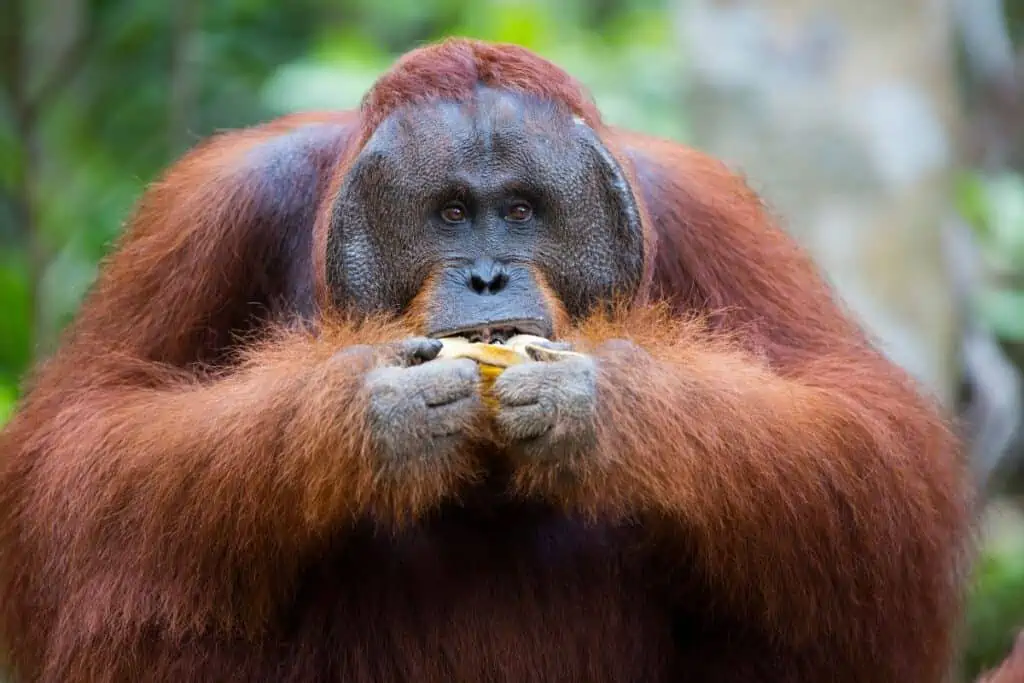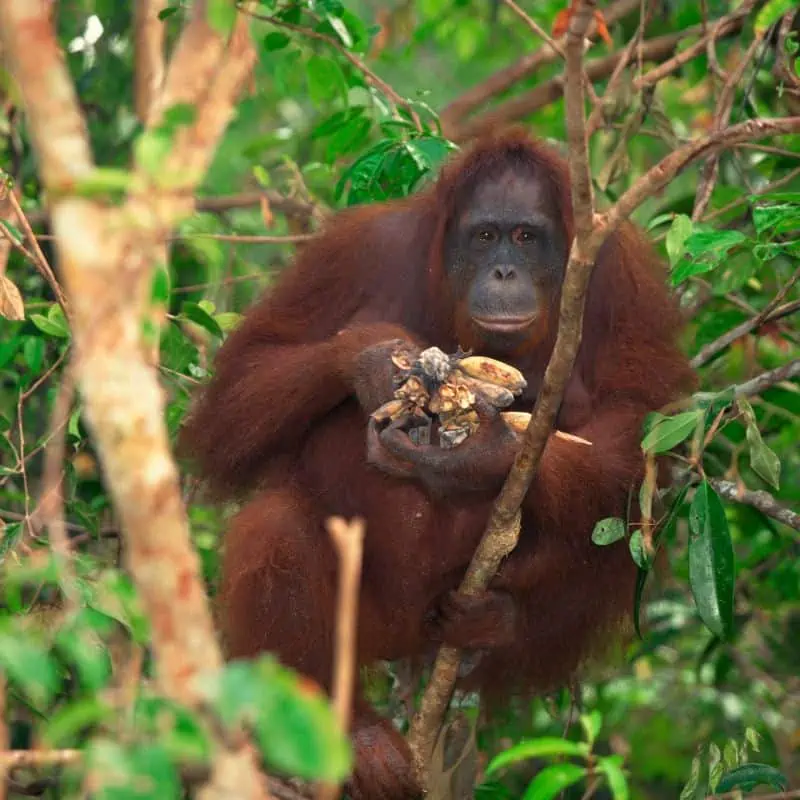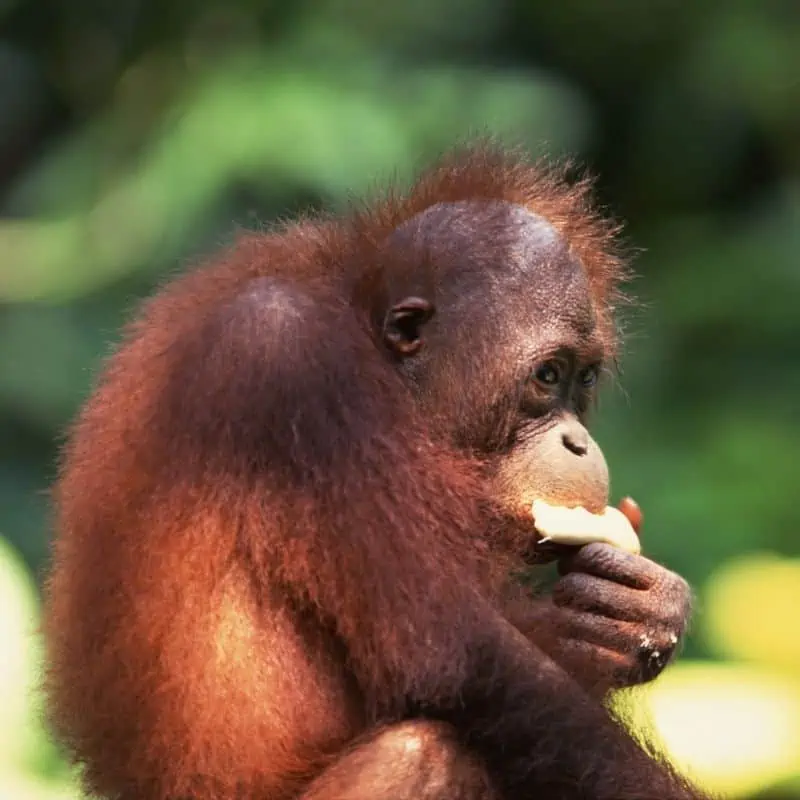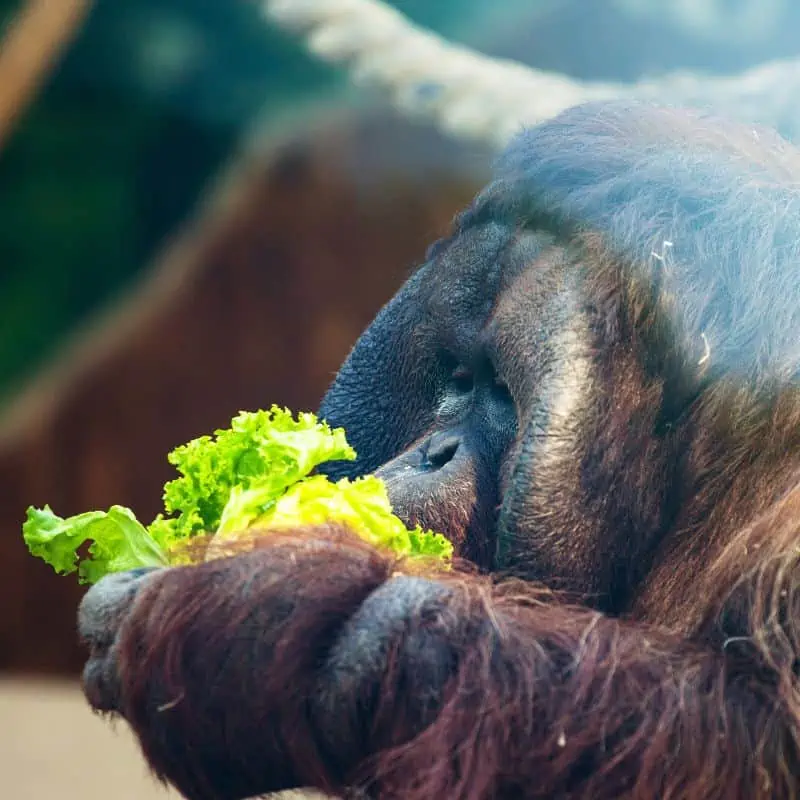Orangutans eat a wide variety of foods, depending on what is available in their environment. Let’s take a closer look at what orangutans eat.
Orangutans are omnivores and frugivores that primarily eat fruit like figs, lychees, mangoes, and bananas. However, they also eat leaves, buds, flowers, bark, soil, honey, and insects. Rarely, they have been known to eat small vertebrates like lizards, birds, rodents, and slow lorises.
This article will discuss what orangutans eat, how much they eat, and how their diet compares to other great apes. So, without further ado, let’s get started.

Orangutan diet and nutrition
Orangutans are the largest arboreal (tree-dwelling) mammals in the world.
There are three species of orangutans: the Bornean orangutan (Pongo pygmaeus), the Sumatran orangutan (Pongo abelii), and the recently discovered (in 2017) Tapanuli orangutan (Pongo tapanuliensis). They live in the tropical rainforests of Borneo and Sumatra, and with this habitat comes a diet that matches.
Orangutans have been known to eat more than 400 different types of fruits, making them one of the most diversely-fed animals on the planet.
Orangutans have a very specialized diet that is unlike any other animal. Their digestive system is specially adapted to breaking down the complex carbohydrates and cellulose in fruit.
They also have a long gut that helps them extract nutrients from their food.
Orangutans eat several different things, including:
Fruit
Fruit makes up approximately 60% of their diet. The type of fruit they eat depends on what is available in their environment.
For example, Bornean orangutans living in the lowlands will primarily eat figs, while those living in the mountains will eat more Drupes (a type of fleshy fruit with a stony pit).
Some of the most common fruits they eat include:
- figs
- lychees
- mangosteens
- ficus fruits
- Rambutans
- Durian
- Cempadak
Flowers, leaves, and bark
Orangutans eat a variety of flowers, leaves, and bark. These make up approximately 25% of their diet. While most of their diet comes from fruit, they will also consume other plant parts when necessary.
For example, they have been known to eat the young leaves of the Gironniera Nervosa tree. This tree is also an essential source of bark for them.
Orangutans will also eat different species of the breadfruit group Artcarpus and genus Baccaurea.

Insects and other small animals
Orangutans have also been known to eat insects and other small animals. This makes up a tiny percentage of their diet.
The type of insect they eat depends on what is available in their environment.
They have been known to eat ants, termites, beetles, and bees. They will also eat small vertebrates like lizards, birds, rodents, and slow lorises.
Eating insects and other small animals provide them with protein and fat, which is essential for their health.
However, this is not a significant part of their diet, and they usually only eat these when other food sources are scarce.
Soil
Orangutans have also been known to eat soil. This may seem strange, but it provides them with essential nutrients like minerals and vitamins.
Eating soil is also thought to help them detoxify their bodies. This is because some of the toxins from the fruits they eat can build up in their bodies over time.
Eating soil helps to remove these toxins from their bodies and keep them healthy.
Do orangutans eat meat?
Orangutans have been known to eat meat rarely. This is primarily limited to small vertebrates such as lizards, birds, rodents, and slow lorises.
It is thought that orangutans only eat meat as a means of supplementing their diet when other food sources are scarce.
The majority of orangutans do not eat meat regularly. However, there have been a few documented cases of orangutans in Sumatra eating meat. One female orangutan named Yet has been known to eat meat three times.
Overall, the orangutan diet is very diverse. They primarily eat fruit but will also consume other plant parts, insects, and small animals.
This helps them to get the nutrients they need to stay healthy and thrive in their natural environment.

How much do orangutans eat?
Orangutans have been known to eat up to 25 different foods per day. However, this number can vary depending on the food availability in their environment.
For example, females consume an average of 9.6 different foods per day. Males consume an average of 7.1 different foods per day.
What do orangutan babies and youngsters eat?
Orangutan babies and young will stay close to their mothers for the first few years of their lives. During this time, they will primarily consume their mother’s milk.
As they get older, they will begin to eat more solid foods. However, they will continue to nurse from their mothers until they are around eight years old. This helps them to get the nutrients they need to grow and develop properly.
When orangutans reach adulthood, they will be able to fend for themselves and find their own food.
However, they will remain close to their mothers and other members of their family group. This helps them to stay safe and protected from predators in the wild.
What do orangutans eat in zoos and sanctuaries?
At zoos and sanctuaries, orangutans are fed a varied diet that includes foods not typically found in their natural habitats, such as sprouts, spinach, carrots, and cabbage.
They are also given treats like peanut butter and papaya.
Some zoos and sanctuaries also provide their orangutans with enrichment foods. This is food that is designed to stimulate their natural foraging behaviors.
Enrichment foods can include items like small parcels filled with rambutan fruit wrapped up in leaves and blades of grass.

Ornagutans diet compared to other apes
The great apes are a group of primates, including gorillas, chimpanzees, orangutans, and bonobos.
They are considered very intelligent animals and share many similarities in their behavior and ecology.
Each of the great apes has its unique diet that reflects the availability of food in its natural environment. However, some general trends can be observed among all of them.
Gorillas diet
Gorillas are the largest of all apes, and they have a mainly vegetarian diet. They eat primarily fruits, stems, shoots, and bamboo.
Western lowland gorillas, on the other hand, consume termites and ants to obtain nutrients.
They smash termite nests open to eat the larvae inside.
Chimpanzees diet
Chimpanzees are the closest living relatives to humans. Chimpanzees are mainly omnivorous, meaning that they eat both plants and animals.
They consume a variety of fruits, nuts, berries, and seeds.
Insects also comprise a significant part of their diet, particularly termites and ants.
They have been known to hunt in groups and use tools to help them catch their prey.
Bonobos diet
Bonobos are one of the most intelligent apes. They share many characteristics with chimpanzees, including their diet.
Bonobos are mainly vegetarian, eating primarily fruits and vegetables.
They eat a wide variety of fruits, including figs, apples, oranges, and bananas. They also eat leaves, seeds, flowers, bark, fungus, and honey.
Final thoughts on the orangutan’s diet
Orangutans are amazing animals that are unfortunately endangered. If we want to help them survive, it is essential to learn about their diet and what they need to stay healthy.
In the wild, orangutans are primarily frugivores, eating fruit, leaves, bark, insects, and small animals.
Overall, orangutans are not picky eaters and will eat anything available to them.
FAQs
What is an orangutan’s favorite fruit?
The orangutan’s favorite fruit is durian. The durian is a large, spiky fruit that grows in Southeast Asia.
Durians are renowned for their potent smell and strange taste. Orangutans search for wild durians in the forest.
What do orangutans drink?
Orangutans get most of the water they need from the succulent fruits they eat.
They also drink water from hollows in trees, on leaves, and on their fur when it rains.
When the need is great, they may go down to a river or stream to drink.
How long do orangutans live?
Orangutans can live to be over 50 years old in captivity.
In the wild, they typically live to be about 35-40 years old

